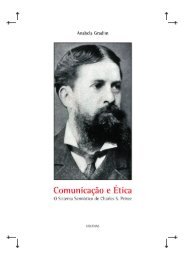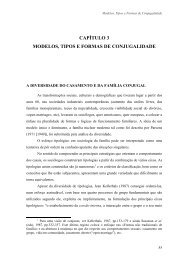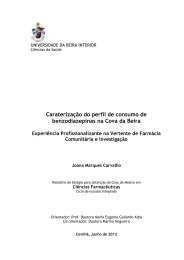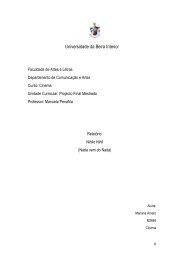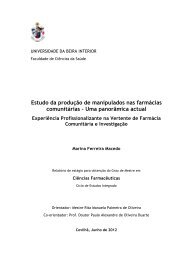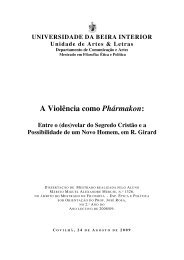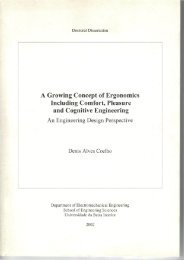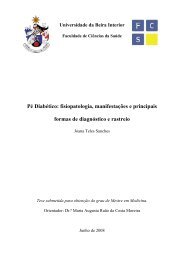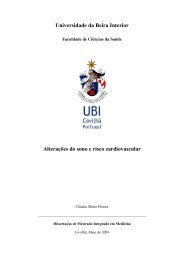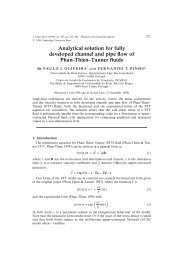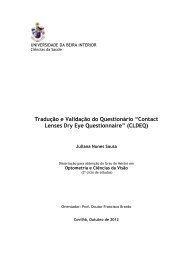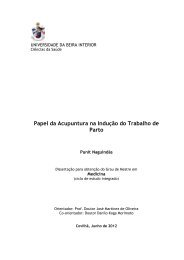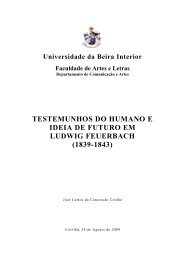Tese_Tânia Vieira.pdf - Ubi Thesis
Tese_Tânia Vieira.pdf - Ubi Thesis
Tese_Tânia Vieira.pdf - Ubi Thesis
Create successful ePaper yourself
Turn your PDF publications into a flip-book with our unique Google optimized e-Paper software.
Chapter III – Results and Discussion<br />
Table 4 –MBC obtained for the different tested nanoparticles.<br />
Materials tested<br />
MBC (µg/mL)<br />
Chitosan/Dextran nanoparticles >107.100<br />
Chitosan solution >62.500<br />
Chitosan/Dextran nanoparticles + AgNPs (NaBH 4 ) 3.000<br />
Chitosan/Dextran nanoparticles + AgNPs (C 6 H 8 O 6 ) 3.000<br />
Chitosan/Dextran nanoparticles + AgNO 3 + C 6 H 8 O 6 23.500<br />
Chitosan/Dextran nanoparticles + AgNO 3 + NaBH 4 94.370<br />
AgNPs (NaBH 4 ) >10.000<br />
AgNPs (C 6 H 8 O 6 ) >10.000<br />
AgNO 3 15.625<br />
1<br />
2<br />
3<br />
4<br />
5<br />
11 12<br />
A<br />
B<br />
Figure 12 – Determination of MIC and MBC by microdilution method in microplate. (A) Image of the<br />
microplate for the determination of the MIC of the nanoparticles in different lines. Chitosan/dextran<br />
nanoparticles (line 1), chitosan/dextran nanoparticles with AgNPs (NaBH 4 ) (line 2), chitosan/dextran<br />
nanoparticles with AgNPs (C 6 H 8 O 6 ) (line 3), chitosan/dextran nanoparticles with AgNO 3 and with NaBH 4 (line<br />
4), and chitosan/dextran nanoparticles with AgNO 3 and with C 6 H 8 O 6 (line 5). A positive control with E. coli<br />
and a negative control with the culture medium are also presented in the columns 11 and 12 respectively.<br />
(B) Image of the agar plate used to determine the MBC of the respective nanoparticles in the microplate.<br />
Due to their small size, AgNPs produced by the reduction of NaBH 4 presented a MIC value<br />
of 10 µg/mL. Those produced by using C 6 H 8 O 6 as reduction agent presented higher values for this<br />
assay, due to their bigger size. This fact can be a disadvantage for the antibacterial activity,<br />
since smaller particles have a larger surface area available for interaction, which enhances the<br />
contact with the bacteria (Martinez-Castanon et al. 2008; Neal 2008; Raffi et al. 2008; Guzmán<br />
et al. 2009; Monteiro et al. 2009; Reicha et al. 2012). Nevertheless, NaBH 4 is toxic for human<br />
cells, which makes C 6 H 8 O 6 more adequate to be used in the organism. There are several reports<br />
in the literature referring to the antibacterial activity of AgNPs. For instance, Kvítev and<br />
collaborators prepared AgNPs by the reduction of diamminesilver ions ([Ag(NH 3 ) 2 ] + ) with D-<br />
maltose obtaining nanoparticles with 26 nm, with a MIC value of 1.69 µg/mL against E. coli<br />
(Kvítek et al. 2008). Another study reported that 10 nm AgNPs inhibit growth of E. coli, with a<br />
40



